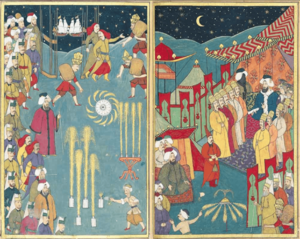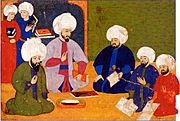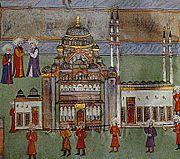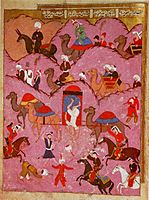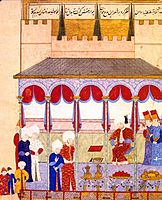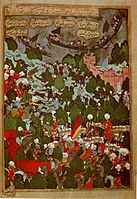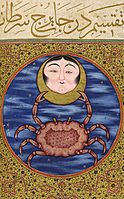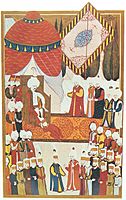Nakkaş Osman facts for kids
Quick facts for kids
Nakkaş Osman
|
|
|---|---|
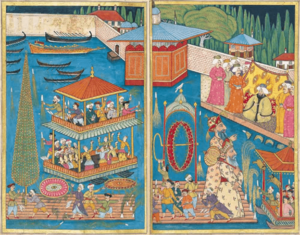
The Surname-i Hümayun parade as illustrated by Nakkaş Osman.
|
|
| Known for | Ottoman miniature |
Nakkaş Osman (sometimes called Osman the Miniaturist) was the chief miniaturist for the Ottoman Empire during the later half of the sixteenth century. The dates of his birth and death are poorly known, but most of his works are dated to the last quarter of the sixteenth century.
The oldest known illustrations of Nakkaş Osman's were made between 1560 and 1570 for a Turkish translation of the epic Persian poem Shahnama by Ferdowsi. He is known to have been the chief illustrator of the various official histories written by Sayyid Lokman for Murad III that were produced in this era, including the Zafername (Book of Victories), the Şahname-ı Selim Han (Book of Kings of Selim Khan). and the Şehinşahname (Book of King of Kings). In 1582 he worked on the astrological Book of Felicity, and around 1585 he was one of the illustrators of the Siyer-i Nebi, an epic on the life of Muhammad written around 1388.
Contents
Style
Osman's illustrative style has been described as "plain, yet perceptive". His illustrations show careful attention to the most minute detail, depicting events in a realistic style.
Osman's portraits tend to display more emotion than those of previous court artists. The tale of Rostam and Sohrab, for example, had heretofore always been represented the same way, with peripheral characters who appear "distant, detached, and still, [and who] scarcely display any trace of facial or bodily expression", whereas in Osman's version Sohrab's groom looks to be "collapsing with grief and shock" as he witnesses Rostam killing his own son.
His work influenced the next generation of court painters in the Ottoman Empire, with the important works of this era derived from his style.
Literature
Nobel Prize-winner Orhan Pamuk's novel My Name Is Red is a fictional account of Osman and his workshop. In the story, Osman blinds himself with a needle, emulating the blindness of the legendary miniaturist Bihzad. In the novel his dying represents "the end of the Ottoman miniature" because after him, the miniaturists follow the art of the West.
Miniatures
-
Depiction of the 1396 Battle of Nicopolis from the Hünername, 1584–88
-
The carrying-in of a model of Süleymaniye Mosque from Surname-i Hümayun, 1582
-
Portrait of Suleyman the Magnificent, Sultan of the Ottoman Empire from 1520 to 1566, from the book Semailname
-
Murder of Ma'sum Beg, the envoy of the Safavid Shah Tahmasp, by Bedouin in the Hejaz, from the Şahname-ı Selim Han (folio 68a)
-
Sultan Selim II receiving Seyyid Lokman and Grand Vizier Sokollu Mehmed Pasha in the Edirne Palace, from the Şahname-ı Selim Han
-
Osman Pasa and Ja'far Pasa, Ottoman governor of Shirvan, in battle against the Cossacks, from the Şehinşahname, 1597–98 (folio 130b)
See also
 In Spanish: Nakkaş Osman para niños
In Spanish: Nakkaş Osman para niños


